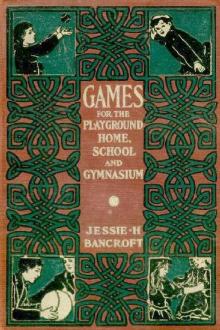Games for the Playground, Home, School and Gymnasium, Jessie Hubbell Bancroft [best books to read for knowledge txt] 📗

- Author: Jessie Hubbell Bancroft
- Performer: -
Book online «Games for the Playground, Home, School and Gymnasium, Jessie Hubbell Bancroft [best books to read for knowledge txt] 📗». Author Jessie Hubbell Bancroft
TEAMS AND OFFICIALS.—The teams consist of from three to six players on each side, though five on a side is the most desirable number. The description of this game and the diagram assume five players to a team. Each team chooses a captain, who settles disputes (unless other officers be appointed for this purpose, as hereinafter stated), and who assigns places for the other players as he sees fit. He himself occupies any place he desires.
Each team is divided into club guards and forwards. For five players there should be three club guards, each standing before a pair of clubs, and two forwards or throwers, who stand near the dividing line. In the placing of players it is desirable to place the best catchers as club guards and the best throwers as forwards. In addition to the team players, it is desirable to have a referee, two judges, and one or two scorers, though all these offices may be filled by the same person.
The referee should keep time, should start the game, should announce scores and settle disputes. The judges, one for each side, should watch for fouls and report points made by their respective sides to their scorers.
OBJECTS.—The objects of the game are (1) to knock over the opponents' clubs with the ball; (2) to make a goal by passing the ball beyond the opponents' club line under the string but not hitting the clubs.
START.—The sides toss up for the ball or choose by drawing cuts (see chapter on "Counting out and Choosing Sides.")
Whenever a ball goes out of bounds it should be returned to the captain of the opposite (catching) side by a player designated for the purpose.
POINTS OF PLAY.—Successful play will come both from throwing and bowling the ball. The best way to throw or bowl the ball is from the extended right arm, the ball being held on the wrist by bending the wrist upward and turning the hand inward over the ball. The right foot should be in the rear and at the start the trunk twisted toward the right. As the ball is thrown, the weight of the body should be changed to the forward leg and the body swung forward nearly half around from the waist toward the left. The best way to stop the ball is usually by blocking it with both arms; but it may be blocked with the legs or the body. The ball may be tossed from player to player on the same side, either to get it into the hands of the best thrower or to mislead the opponents as to when it will be aimed at their clubs. Players may move about on their own side, but overstepping the boundary lines is a foul. Club guards should not get far away from their line of duty. The ball should be aimed at the clubs or at open spaces between players, not at the players themselves.
FOULS.—It is a foul for a ball to pass above the cord drawn over the opponents' club line. Such a foul scores one for the defensive side. It is a foul for a thrower to step over the center line. For this the opponents score two points. It is a foul for a club to be overturned by a player on his own side. Each club so overturned scores five points for the opponents.
SCORE.—Overturning an opponent's club with the ball scores five points. Passing the ball beyond the opponents' club line below the cord but without hitting the clubs scores three points.
A ball passing between a pair of clubs scores ten.
A ball passing between the legs of an opposing player scores ten.
No score is made on a ball caught by the opponents.
Fouls score as stated above.
The game is played in ten or fifteen minute halves, with five minutes' intermission, the team winning which has the highest score at the end of the second half.
It adds greatly to the interest of the game to post the score in sight of the players, on a blackboard, large paper, or other bulletin.
This game was originated by Dr. Dudley A. Sargent.
BOMBARDMENT10 to 100 players.
Playground; gymnasium.
Basket ball; Indian clubs.
This game resembles Battle Ball in that it consists in trying to overturn Indian clubs or tenpins set up in the opponents' court. The game differs from Battle Ball, however, in being feasible for a much larger number of players, and in being very much simpler in its form, not having the closer team organization or such a variety in points of scoring as Battle Ball. It may be made one of the liveliest and most interesting games for large numbers of players.
GROUND.—The ground is divided into two equal fields by a line across the center. At the rear of each ground a row of Indian clubs or tenpins is set up, there being the same number of pins as players. Should the number of pins be so great as to require their being closer than two feet apart, a second row should be placed in front of the first, in such a way that each club stands opposite a space in the preceding row of clubs.
PLAYERS.—The players are divided into two teams numbering anywhere from five to fifty each. The players stand between their clubs and the dividing line in any scattered formation. With a large number of players several balls should be put in play.
OBJECT AND POINTS OF PLAY.—The object of the game is to knock down the opponents' clubs. Each player will therefore serve both as a guard to protect his clubs, and as a thrower. He may throw whenever he can secure a ball, there being no order in which players should throw. Balls may be made to displace the opponents' clubs by being thrown against the wall behind the clubs, so that they will rebound or carrom, knocking the clubs down from the rear. No player may step across the center line. The game is especially interesting when several balls are in play at once.
SCORE.—Each club overturned scores one point for the side which knocked it down. Every club overturned by a player on his own side scores one for the opponents. The game is played in time limits of from ten to twenty minutes, the side winning which has the highest score at the end of that time.
BOUNDARY BALL10 to 100 players.
Playground; gymnasium.
Basket ball.
GROUND.—The ground should measure about twenty feet in width by forty in length, and should be divided in half by a line, marked across it.
PLAYERS.—The players, numbering anywhere from ten to one hundred, are divided into two equal parties. Each party lines up on one side of the dividing line and about ten feet from it.
OBJECT OF THE GAME.—The object of the game is to throw the ball over the opponents' rear boundary line, a party succeeding in doing this scoring a point. As each party lines up at the start ten feet from the center dividing line, it is possible for each to intercept the ball at the point of its line-up. Any players from the line, however, may run back of this line-up to prevent the ball from going over the rear boundary, and the point at which the ball is stopped by any such player indicates the point at which the party must line up for the next play. It therefore becomes a secondary object of the game to force one's adversaries back until they have reached their rear boundary line, where their chances for intercepting the ball are less than in a forward position, as their movements are more restricted.
For instance, party A throws the ball at party B's boundary. The latter, by running backward several paces, succeeds in intercepting the ball at a distance of say five feet beyond its first line-up. The entire party then takes its stand on this new line and throws the ball at its opponents' boundary, trying to force them back in similar manner as far as possible to catch the ball.
START.—The parties toss up for which side shall first have the ball. The ball is then given to the center player in the line, who makes the first throw. After this first throw the ball may be put in play by any player in a line.
RULES AND POINTS OF PLAY.—Players may run forward of their first or succeeding line-up to catch the ball, but the line-up never comes forward of its first position. After a line has been forced backward, however, if the ball be caught anywhere between the last line-up and the first, the line moves forward to the new point. Should a ball roll on the ground, the point at which it stops rolling, or is stopped by the players trying to catch it, indicates the line at which they must take their stand. No ball scores a point, however, which rolls beyond the rear boundary line. When a party has been forced back to its rear boundary line, it must stand on that line thereafter, unless it should succeed in stopping the ball forward of that line, when it may move forward to the new position. No player may step over the boundary line.
SCORE.—One point is scored by the throwing party every time a ball is thrown beyond the opponents' rear boundary line. Five points constitute a game.
BOUND BALL10 to 30 players.
Playground; gymnasium.
Tennis ball; hand ball.
This game somewhat resembles tennis, but is played over a lower dividing line, and the ball is batted with the hand instead of with a racket; it is always played from a bound, never "on the fly."
GROUND.—Boundary lines for the entire court should be outlined, measuring about fifty feet in length by twenty-five in width, though these dimensions are not invariable. The ground is then divided by a line into two equal parts. In a gymnasium balance beams may be set up for this purpose. Out of doors a board or log may be used, or the mere drawing of a line on the ground will suffice.
PLAYERS.—The players are divided into two equal parties which take their places on either side of the dividing line, scattered over their respective courts without regular formation.
OBJECT.—The game consists in batting a tennis or hand ball with the hand from one side to the other of the dividing line, after it has first bounded in one's own territory.
START.—The leader of the game, or any player on either side, puts the ball in play by throwing it among the players of the opposite side. Whoever catches the ball acts as the first server. The server serves by bounding the ball once and then hitting or batting it with the open palm on the rebound, so that it will go over into the opponents' court. Should a served ball fail to rebound in the antagonists' court, it is returned to the party from which it came, that they may have a second trial. One player continues to serve until his side scores five, when the ball is thrown to the opponents. The players on a side serve in rotation.
RULES AND POINTS OF PLAY.—In returning a serve or keeping the ball in play at any time, it may be bounced any number of times before being sent into the opponents' court. The one essential point is that it should be kept bounding, a ball that is dead being thrown





Comments (0)